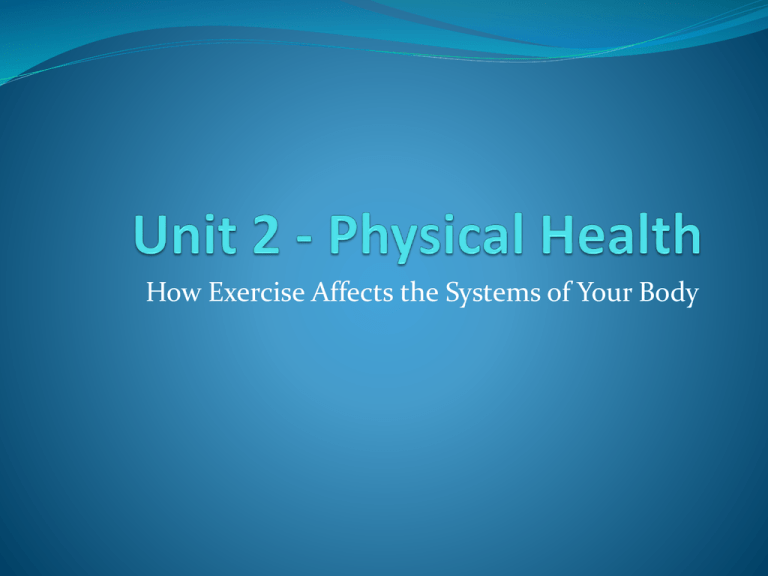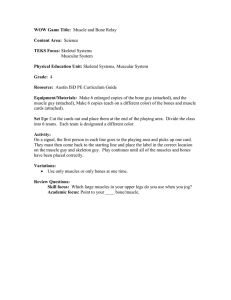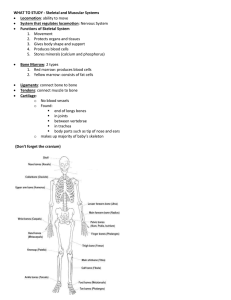Unit 2 - Physical Health
advertisement

How Exercise Affects the Systems of Your Body Physical Health How well your body functions Why exercise? Can help prevent: Cardiovascular disease Certain cancers Diabetes High Blood Pressure Improves Stamina, Flexibility, and Strength Controls Weight Improves Quality of Life Affects both social and mental health Physical Health Affects every system in your body Key systems to be discussed: Cardiovascular Respiratory Muscular Skeletal Nervous Brain Cardiovascular System Cardiovascular System – AKA the Circulatory System – is an organ system that encompasses the heart and blood vessels of the body Function - carries blood, oxygen, and nutrients to organs and tissues of the body, and carries waste and carbon dioxide from these tissues for removal from the body Heart causes blood to flow away from the heart Bodily movement causes blood to efficiently flow back to the heart Muscles pressing on veins help push blood back towards the heart The heart is a constantly working muscle The Heart Any exercise will strengthen muscle More exercise = stronger heart Stronger heart = less work to do at rest Higher cardiac output – more blood is expelled from the heart per beat Less work to do at rest = lower resting heart rate (RHR) More exercise = better blood and oxygen flow Blood Vessels and Pressure Increased exercise will increase cardiac output and lower heart rate Helps regulate fluid and promotes capillary formation Amount of fluid in blood greatly determines blood pressure More fluid = more pressure Respiratory System Function - to supply the blood with oxygen in order for the blood to deliver oxygen to all parts of the body Made up of Mouth Nose Trachea Lungs Diaphragm Respiratory System Improves lung capacity Blood flow increases to alveoli Allows better Oxygen / CO2 exchange Respiratory System Controls mucus which may settle in the lungs Increases endurance of Diaphragm and Intercostals Nervous System – The Brain More exercise = better blood flow to the brain Exercise causes the release of endorphins which make you feel good Studies show consistent exercise = better brain development in children Underuse will result in a decline in function The Brain Exercise seems to slow or reverse the natural declination of brain function starting in our twenties. New studies seem to show that adult brains are capable of neurogenesis (creation of new brain cells) Adults were previously thought to be unable to do this Exercise is thought to jumpstart neurogenesis Exercise seems to prompt an increase in Brain-Derived Neurotropic Factor (BDNF) Exercise does not have to be exhaustive! The Brain BDNF: Strengthens brain cells and axons Fortifies connections among neurons and sparks neurogenesis Most people have higher levels of BDNF in blood after exercise This does not fully explain all the brain changes associated with exercise Muscular System Helps with strength and endurance Supply and demand The more you exercise, the more demand there is on your muscles which leads to an increase in strength and endurance More exercise = more blood flow = increased muscle growth Diagram of a Skeletal Muscle Muscular System Increase workload = increased stress on muscles 2. Increased stress result in micro-tears in muscle fibers 3. Natural repair process repairs the tear 1. a) b) Overcompensates by adding bigger cells to build a stronger fiber. Over time, this repeated process of teardown and re-build will result in muscle growth Hypertrophy – muscle growth Your body does not actually make more muscle but the muscle fibers which make up your muscle get larger Muscular System An established exercise routine results in an increase in Mitochondria in muscles Mitochondria use oxygen to create energy Glucose + Pyruvate + NADH = ATP (adenosine triphosphate) Process occurs because of the presence of oxygen Increase in number of blood vessels in muscle tissue Skeletal System Consists of: Bones, ligaments, and cartilage Functions - support, movement, protection, blood cell production, calcium storage and endocrine regulation Skeletal System Diagram of a Bone Skeletal System Bones Contain marrow that produce blood cells Ligaments Fibrous connective tissue attached to bones and many internal organs Helps limit movements induced by tendons Keeps internal organs in place Cartilage Holds some bones together, helps in the formation of bones in growing children and prevents bones from rubbing each other. Skeletal System Physical Activity promotes: Increased synovial fluid production Maintains and increases joint range of movement Increased bone density Stronger ligaments Skeletal System Synovial Fluid – oil-like fluid produced at joints to keep cartilage lubricated and nourished Production of synovial fluid is an acute (short-term) response to exercise More exercise means = more synovial fluid Joints need regular exercise to stay lubricated, nourished and healthy. More fluid = better range of motion Lack of exercise causes joints to “dry up” Skeletal System Increased Bone Density Weight-bearing and cardiovascular exercises put stress on bones Body responds by creating osteoblasts Osteoblasts – cells which build new bone and make bones stronger and denser Increased bone density helps prevent osteoporosis Osteoporosis – weakening of bone Skeletal System Stronger Ligaments Ligaments are exposed to the same stresses of exercise Slowly develop strength




